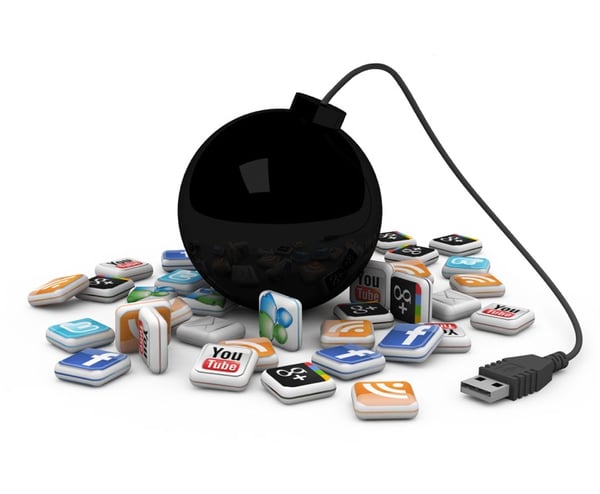Ready for the next Tweet storm, Facebook faux pas or sexting scandal? With the right preparation and strategy, managing a social media crisis is … well, manageable.

Using social media platforms in a crisis is a powerful tool. While that may cause a few racing hearts for those charged with orchestrating a crisis response, fact is, social media benefits emergency management as well.
Social media provides a lot of information to the public fast! And speed is a critical factor, because if we are not first to frame the incident, others will tell the story.
With the good comes the bad, and ugly.
In today’s digital age with its explosion of social media platforms, it should come as no shocker that a student or staff member is going to tweet, post, blog, share photos or videos that will leave us incredulously shaking our heads. Or worse, becoming a viral firestorm.
These risks may include:
-
Cyberbullying or other online conflicts
-
Public ridicule or shaming
-
Negative posts
-
Embarrassing or inappropriate photos and information
-
Rapid and widespread communication of crisis-related rumors or false information about what happened and who was involved
Social Media Crisis vs Social Media Issue
The first step in knowing how to deal with a crisis is to understand what is a crisis?
A social media crisis is an online incident that negatively impacts an organization (district, school) or persons (students, employees). It often triggers negative emotions that can:
-
Outweigh common sense
-
Elicit anger or create backlash from stakeholders and others
-
Provoke viral behavior
Another way to gauge a social media crisis is whether one or more of these situations exist as it plays out real time:
-
You don’t know what’s happening (but the larger public may)
-
There is a decisive change in the norm (social chatter vs markedly different line of criticism)
-
An issue with a broad impact or interest is raised
-
An issue or incident that has a clear impact on the district or school
A social media issue is less serious, but left unresolved promptly runs the risk of escalating into a crisis. Examples might be:
-
Negative comments or discussions posted on social media sites
-
Unacceptable comments in response to social media posts
-
Negative stakeholder experiences
-
Negative media coverage
Social Media Policy
There are several commonalities among school systems impacted by a social media crisis, including a lack of:
-
Professionals schooled in social media and crisis response;
-
A social media crisis communication plan; and
-
Proper employee and student education, including an appropriate governance framework to prevent misuse of and misinformation on social media.
Two critical elements of a governance framework are a social media policy that provides guidelines for proper use of social media platforms, and “use of” practices that outline how to respond to positive and negative situations (see example in Resource section).
Crisis Communication Plan
One of the most important aspects of a social media crisis communication plan is monitoring the conversations occurring across your social media platforms. Be prepared to:
-
Ask yourself, is there a need to respond? At times the best action is to simply not respond.
-
Respond in the venue where the crisis first broke, then in other venues that have picked up on the crisis. If your strategy is to reach a larger audience of stakeholders, consider these elements as part of your response:
-
Acknowledge a crisis exists (become the primary source of information)
-
Details about the incident (inform employees first, they’re the best defense against inaccurate info)
-
Specific actions taken to address the incident
-
Real or potential impacts (short- and long-term)
-
Steps taken to prevent future occurrence
-
Reaffirm your district’s social media policies (if you don’t have one, craft one)
Consider these additional steps to handling a social media crisis:
-
Rely on advocates and allies (they are often more effective in responding)
-
Rule of 3: Never send a third reply when responding online. A third reply is an argument, not an answer. On the third reply, go offline.
Post-crisis, it’s important to assess its impact on the organization and stakeholders. Based on this analysis make any course corrections to your crisis communications plan and social media response guidelines. Be sure to share any revisions with students and employees.
I’d love to hear your comments, feedback or your tips. Feel free to share so we become a community of learners.
 Rick J. Kaufman, APR is the executive director of community relations and emergency management for Bloomington (MN) Public Schools. He is a nationally respected consultant, trainer and author on crisis management and communication. He served as the Crisis Response Team lead for the Columbine High School tragedy in 1999, and continues to work with school districts across the country to manage and recover from school violence incidents, including Broward County Public Schools and San Bernardino City Unified Public Schools. Mr. Kaufman is the author of the Complete Crisis Communication Management Manual for Schools (2016, NSPRA).
Rick J. Kaufman, APR is the executive director of community relations and emergency management for Bloomington (MN) Public Schools. He is a nationally respected consultant, trainer and author on crisis management and communication. He served as the Crisis Response Team lead for the Columbine High School tragedy in 1999, and continues to work with school districts across the country to manage and recover from school violence incidents, including Broward County Public Schools and San Bernardino City Unified Public Schools. Mr. Kaufman is the author of the Complete Crisis Communication Management Manual for Schools (2016, NSPRA).
.png)